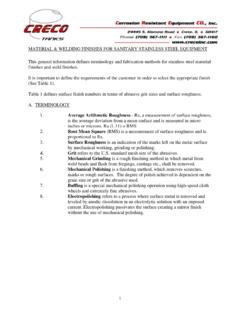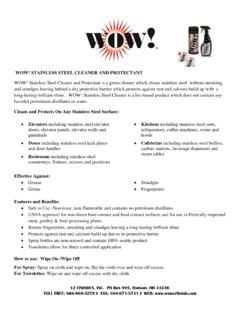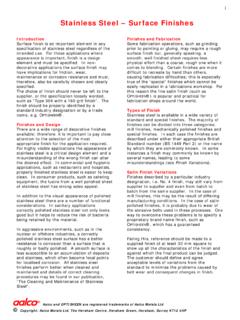Transcription of Stainless Steel Care and Cleaning Instructions
1 Stainless Steel care and Cleaning Instructions Cleaning of Stainless Steel Stainless steels need to be cleaned for aesthetic considerations and to preserve corrosion resistance. Stainless Steel is protected from corrosion by a thin layer of chromium oxide. Oxygen from the atmosphere combines with the chromium in the Stainless Steel to form this passive chromium oxide film that protects from further corrosion. Any contamination of the surface by dirt, or other materials, hinders this passivation process and traps corrosive agents, reducing corrosion protection. Thus, some form of routine Cleaning is necessary to preserve the appearance and integrity of the surface.
2 Stainless steels are easily cleaned by many different methods. They actually thrive with frequent Cleaning , and unlike some other materials, it is impossible to "wear out" Stainless Steel by excessive Cleaning . The effect of surface/pattern roughness, grain/pattern orientation, and designs that allow for maximum rain Cleaning (exterior applications). should be considered. Types of surface contaminants Like any surface that is exposed to the environment, Stainless Steel can get dirty. Dirt and soil can consist of accumulated dust and a variety of contaminates that come from many sources, ranging from the wind to everyday use.
3 These contaminates will vary greatly in their effect on appearance and corrosivity and ease of removal. While some may be easily removed, others may require specific cleaners for effective removal. It may be necessary to identify the contaminate or experiment with various cleaners. Frequently, warm water with or without a gentle detergent is sufficient. Next in order are mild non-scratching abrasive powders such as typical household cleaners. These can be used with warm water, bristle brushes, sponges, or clean cloths. Ordinary carbon Steel brushes or Steel wool should be avoided as they may leave particles embedded on the surface which can lead to rusting.
4 For more aggressive Cleaning , a small amount of vinegar can be added to the scouring powder. Cleaning should always be followed by rinsing in clean hot water. When water contains mineral solids, which leave water spots, it is advisable to wipe the surface completely with dry towels. Fingerprints and stains 1. Fingerprints and mild stains resulting from normal use in consumer and architectural applications are the most common surface contaminates. Fortunately, these usually affect only appearance and seldom have an effect on corrosion resistance. They are easy to remove by a variety of simple Cleaning methods.
5 Fingerprints are probably the most troublesome marks to remove from the surface of smooth polished or bright finished Stainless Steel . Fortunately, they can be removed with a glass cleaner or by gentle rubbing with a paste of soda ash (sodium carbonate) and water applied with a soft rag. Once again, this should be followed by a thorough warm water rinse. Shop oil and grease Shop oils, which may carry grease, grit and metal chips, commonly produce surface soiling after many shop operations. Grease and other contaminates may also soil surfaces in food preparation and many other household and commercial situations.
6 These soils may be corrosive in themselves or may not allow the surface to maintain passivity, and so periodic removal is a necessity. Initially, soap or detergent and water may be tried or a combination of detergent and water plus a solvent. The removal of oil and grease from Stainless Steel in chemical solvents is frequently used with using parts that are laden with lubricants. This process, in its simplest form, consist of bringing liquid solvent into contact with the surface to be cleaned and allowing dissolution to take place; for example, washing a surface with Trichloroethylene or similar liquid solvent.
7 Non halgenated solvents, such as acetone, methyl, ethyl alcohol, methyl ketene, benzene, isopropyl alcohol, toluene, mineral spirits, and turpentine work well. Many of these solvents are widely used as individual cleaners, but there are thousands of blended or compound cleaners on the market. Users are advised to contact suppliers of solvents for information on their applications on Stainless Steel . Types of Cleaners and Methods In selecting Cleaning practices, consider the possibility of scratching and the potential for post- Cleaning corrosion caused by incompletely removed cleaners.
8 Scratching can occur on bright mirror finish by cleaners that contain hard abrasives, or even by grit in wash water. This is usually not a problem on dull finishes or those surfaces finished with a coarse polishing grit. The best preventative measure is to avoid using abrasive cleaners unless absolutely necessary. When abrasives are needed, first experiment on an inconspicuous area. A soft abrasive such as pumice, should be used. Abrasives can permanently damage some colored and highly polished finishes. Advice should be obtained from the manufacture when Cleaning special finishes. Many cleaners contain corrosive 2.
9 Ingredients which require thorough post-clean rinsing with clean water;. however, thorough rinsing is recommended for all Cleaning procedures. Clean Water and Wipe Dry The simplest, safest, and least costly method that will adequately do the job is always the best method. Stainless surfaces thrive with frequent Cleaning because there is no surface coating to wear off Stainless steels. A. soft cloth and clean warm water should always be the first choice for mild stains and loose dirt and soils. A final rinse with clean water and a dry wipe will complete the process and eliminate the possibility of water stains.
10 Solvent Cleaning Organic solvents can be used to remove fresh fingerprints and oils and grease that have not had time to oxidize or decompose. The preferred solvent is one that does not contain chlorine, such as acetone, methyl alcohol, and mineral spirits. There are many compounded or blended organic cleaners that are commercially available and attempt to optimize both cleanability and safety attributes. Cleaning can be accomplished by, wiping with solvent impregnated cloths,. The wiping technique sometimes leaves a streaked surface. Household Cleaners Household Cleaners fall into two categories: detergent (non abrasive) and abrasive cleaners.








